Diploma of Business: Customer Relationship Management Case Study
VerifiedAdded on 2022/10/12
|12
|3162
|147
Case Study
AI Summary
This case study examines the implementation of a new Customer Relationship Management (CRM) system, Sugar CRM, by Tourism Holding Limited (THL). The analysis focuses on the competitive strategies THL gained through business process mapping, pipelined management, and automation of quotes. It highlights the importance of CRM in differentiating customers and building lasting relationships. The stakeholders affected, including management, employees, and customers, are identified, along with the crucial role of information technology in CRM. The study explores how CRM enhances customer insights, communication, and data collection. Finally, it details the components of CRM, including salesforce automation, customer service, and workflow automation, and their contribution to THL's success. The document provides a comprehensive overview of CRM's impact on THL's operations and competitive advantage, based on the provided case study and related literature.
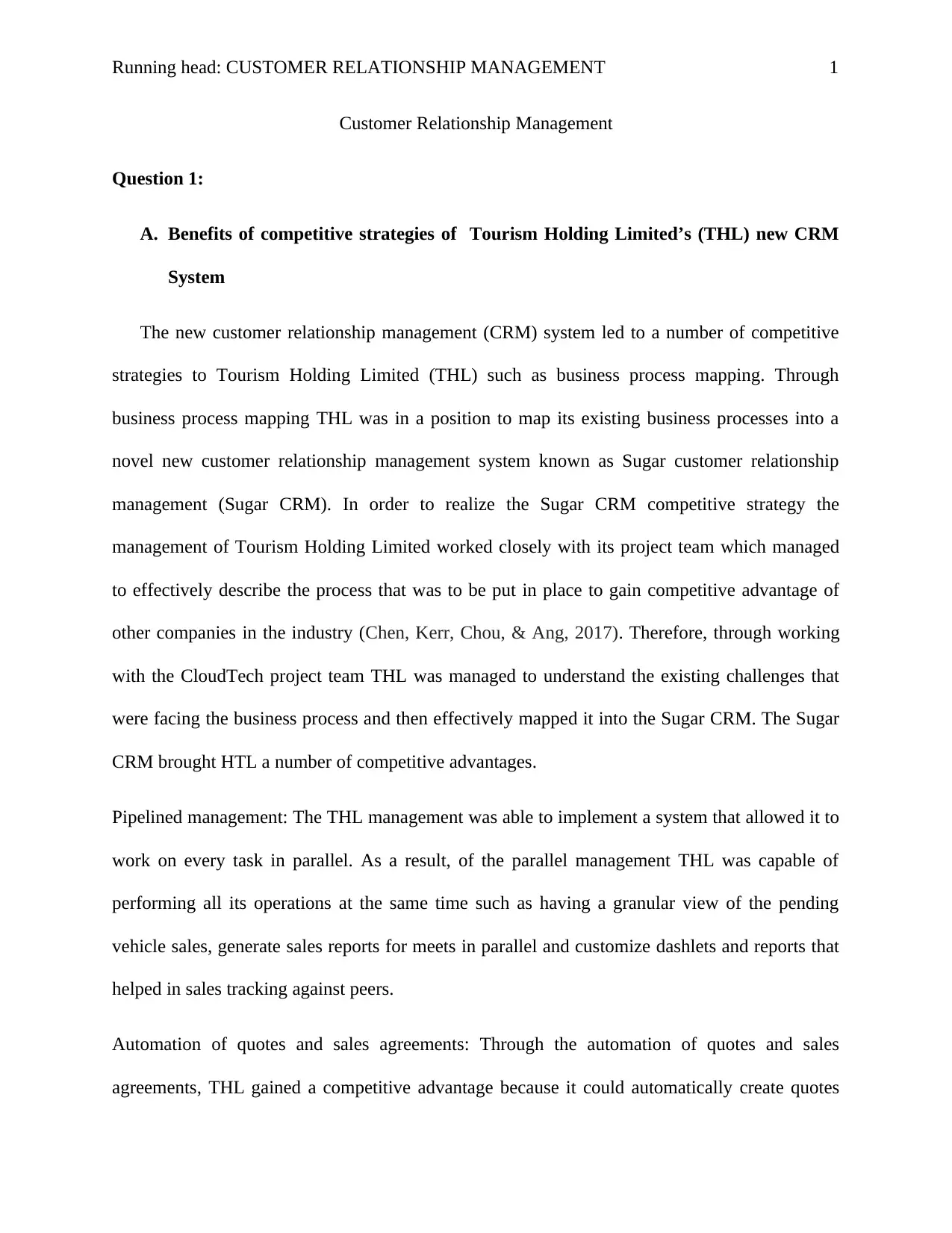
Running head: CUSTOMER RELATIONSHIP MANAGEMENT 1
Customer Relationship Management
Question 1:
A. Benefits of competitive strategies of Tourism Holding Limited’s (THL) new CRM
System
The new customer relationship management (CRM) system led to a number of competitive
strategies to Tourism Holding Limited (THL) such as business process mapping. Through
business process mapping THL was in a position to map its existing business processes into a
novel new customer relationship management system known as Sugar customer relationship
management (Sugar CRM). In order to realize the Sugar CRM competitive strategy the
management of Tourism Holding Limited worked closely with its project team which managed
to effectively describe the process that was to be put in place to gain competitive advantage of
other companies in the industry (Chen, Kerr, Chou, & Ang, 2017). Therefore, through working
with the CloudTech project team THL was managed to understand the existing challenges that
were facing the business process and then effectively mapped it into the Sugar CRM. The Sugar
CRM brought HTL a number of competitive advantages.
Pipelined management: The THL management was able to implement a system that allowed it to
work on every task in parallel. As a result, of the parallel management THL was capable of
performing all its operations at the same time such as having a granular view of the pending
vehicle sales, generate sales reports for meets in parallel and customize dashlets and reports that
helped in sales tracking against peers.
Automation of quotes and sales agreements: Through the automation of quotes and sales
agreements, THL gained a competitive advantage because it could automatically create quotes
Customer Relationship Management
Question 1:
A. Benefits of competitive strategies of Tourism Holding Limited’s (THL) new CRM
System
The new customer relationship management (CRM) system led to a number of competitive
strategies to Tourism Holding Limited (THL) such as business process mapping. Through
business process mapping THL was in a position to map its existing business processes into a
novel new customer relationship management system known as Sugar customer relationship
management (Sugar CRM). In order to realize the Sugar CRM competitive strategy the
management of Tourism Holding Limited worked closely with its project team which managed
to effectively describe the process that was to be put in place to gain competitive advantage of
other companies in the industry (Chen, Kerr, Chou, & Ang, 2017). Therefore, through working
with the CloudTech project team THL was managed to understand the existing challenges that
were facing the business process and then effectively mapped it into the Sugar CRM. The Sugar
CRM brought HTL a number of competitive advantages.
Pipelined management: The THL management was able to implement a system that allowed it to
work on every task in parallel. As a result, of the parallel management THL was capable of
performing all its operations at the same time such as having a granular view of the pending
vehicle sales, generate sales reports for meets in parallel and customize dashlets and reports that
helped in sales tracking against peers.
Automation of quotes and sales agreements: Through the automation of quotes and sales
agreements, THL gained a competitive advantage because it could automatically create quotes
Paraphrase This Document
Need a fresh take? Get an instant paraphrase of this document with our AI Paraphraser
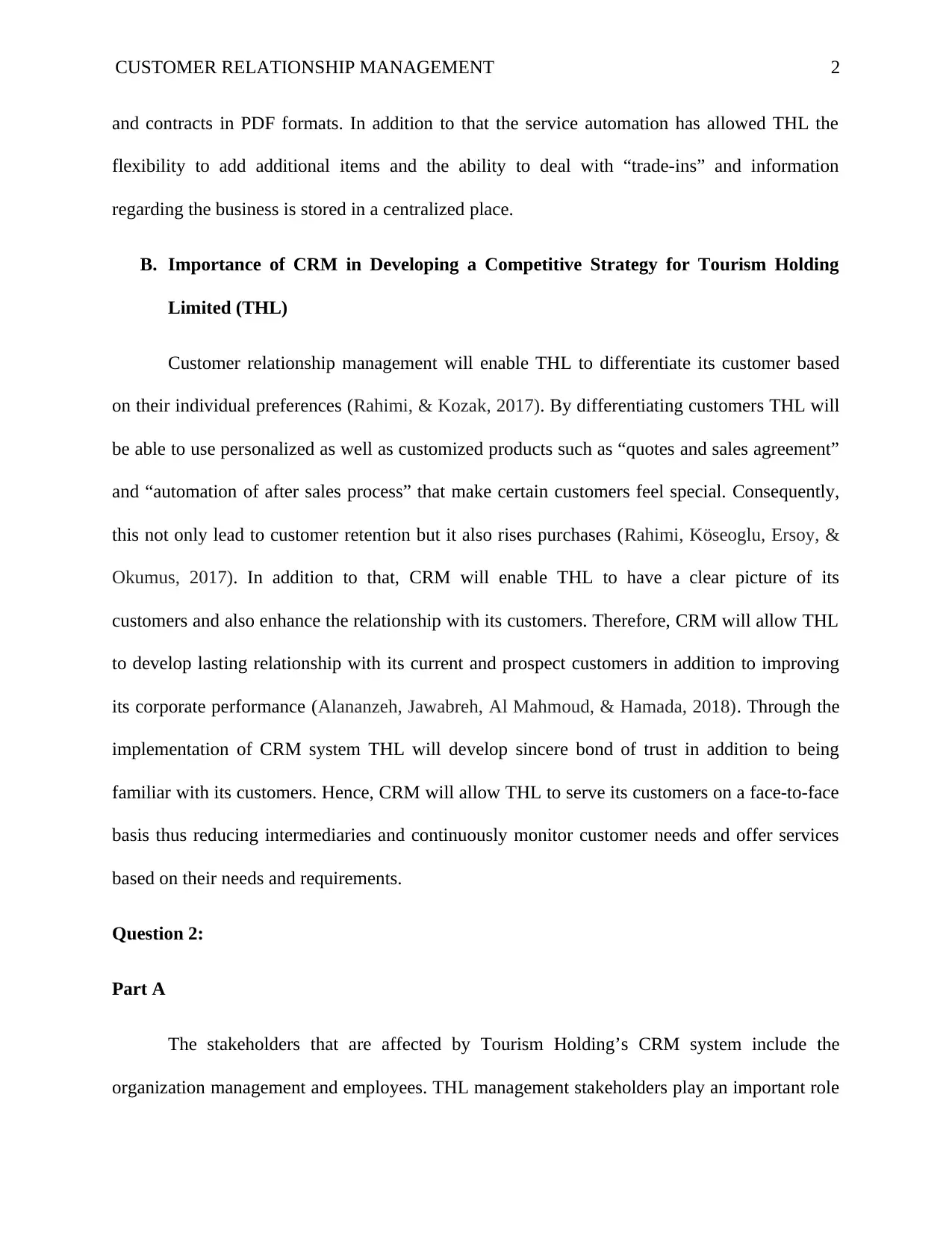
CUSTOMER RELATIONSHIP MANAGEMENT 2
and contracts in PDF formats. In addition to that the service automation has allowed THL the
flexibility to add additional items and the ability to deal with “trade-ins” and information
regarding the business is stored in a centralized place.
B. Importance of CRM in Developing a Competitive Strategy for Tourism Holding
Limited (THL)
Customer relationship management will enable THL to differentiate its customer based
on their individual preferences (Rahimi, & Kozak, 2017). By differentiating customers THL will
be able to use personalized as well as customized products such as “quotes and sales agreement”
and “automation of after sales process” that make certain customers feel special. Consequently,
this not only lead to customer retention but it also rises purchases (Rahimi, Köseoglu, Ersoy, &
Okumus, 2017). In addition to that, CRM will enable THL to have a clear picture of its
customers and also enhance the relationship with its customers. Therefore, CRM will allow THL
to develop lasting relationship with its current and prospect customers in addition to improving
its corporate performance (Alananzeh, Jawabreh, Al Mahmoud, & Hamada, 2018). Through the
implementation of CRM system THL will develop sincere bond of trust in addition to being
familiar with its customers. Hence, CRM will allow THL to serve its customers on a face-to-face
basis thus reducing intermediaries and continuously monitor customer needs and offer services
based on their needs and requirements.
Question 2:
Part A
The stakeholders that are affected by Tourism Holding’s CRM system include the
organization management and employees. THL management stakeholders play an important role
and contracts in PDF formats. In addition to that the service automation has allowed THL the
flexibility to add additional items and the ability to deal with “trade-ins” and information
regarding the business is stored in a centralized place.
B. Importance of CRM in Developing a Competitive Strategy for Tourism Holding
Limited (THL)
Customer relationship management will enable THL to differentiate its customer based
on their individual preferences (Rahimi, & Kozak, 2017). By differentiating customers THL will
be able to use personalized as well as customized products such as “quotes and sales agreement”
and “automation of after sales process” that make certain customers feel special. Consequently,
this not only lead to customer retention but it also rises purchases (Rahimi, Köseoglu, Ersoy, &
Okumus, 2017). In addition to that, CRM will enable THL to have a clear picture of its
customers and also enhance the relationship with its customers. Therefore, CRM will allow THL
to develop lasting relationship with its current and prospect customers in addition to improving
its corporate performance (Alananzeh, Jawabreh, Al Mahmoud, & Hamada, 2018). Through the
implementation of CRM system THL will develop sincere bond of trust in addition to being
familiar with its customers. Hence, CRM will allow THL to serve its customers on a face-to-face
basis thus reducing intermediaries and continuously monitor customer needs and offer services
based on their needs and requirements.
Question 2:
Part A
The stakeholders that are affected by Tourism Holding’s CRM system include the
organization management and employees. THL management stakeholders play an important role
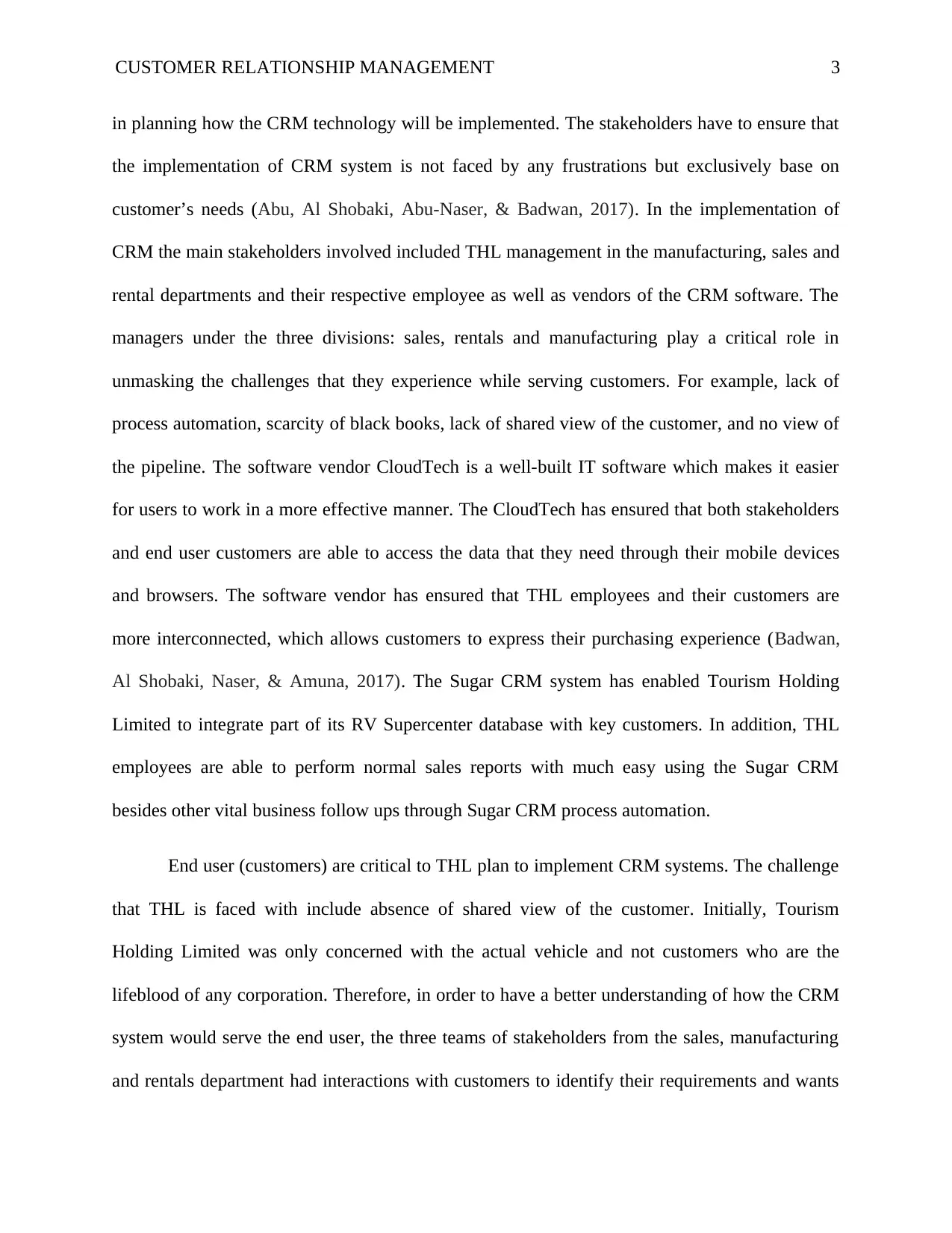
CUSTOMER RELATIONSHIP MANAGEMENT 3
in planning how the CRM technology will be implemented. The stakeholders have to ensure that
the implementation of CRM system is not faced by any frustrations but exclusively base on
customer’s needs (Abu, Al Shobaki, Abu-Naser, & Badwan, 2017). In the implementation of
CRM the main stakeholders involved included THL management in the manufacturing, sales and
rental departments and their respective employee as well as vendors of the CRM software. The
managers under the three divisions: sales, rentals and manufacturing play a critical role in
unmasking the challenges that they experience while serving customers. For example, lack of
process automation, scarcity of black books, lack of shared view of the customer, and no view of
the pipeline. The software vendor CloudTech is a well-built IT software which makes it easier
for users to work in a more effective manner. The CloudTech has ensured that both stakeholders
and end user customers are able to access the data that they need through their mobile devices
and browsers. The software vendor has ensured that THL employees and their customers are
more interconnected, which allows customers to express their purchasing experience (Badwan,
Al Shobaki, Naser, & Amuna, 2017). The Sugar CRM system has enabled Tourism Holding
Limited to integrate part of its RV Supercenter database with key customers. In addition, THL
employees are able to perform normal sales reports with much easy using the Sugar CRM
besides other vital business follow ups through Sugar CRM process automation.
End user (customers) are critical to THL plan to implement CRM systems. The challenge
that THL is faced with include absence of shared view of the customer. Initially, Tourism
Holding Limited was only concerned with the actual vehicle and not customers who are the
lifeblood of any corporation. Therefore, in order to have a better understanding of how the CRM
system would serve the end user, the three teams of stakeholders from the sales, manufacturing
and rentals department had interactions with customers to identify their requirements and wants
in planning how the CRM technology will be implemented. The stakeholders have to ensure that
the implementation of CRM system is not faced by any frustrations but exclusively base on
customer’s needs (Abu, Al Shobaki, Abu-Naser, & Badwan, 2017). In the implementation of
CRM the main stakeholders involved included THL management in the manufacturing, sales and
rental departments and their respective employee as well as vendors of the CRM software. The
managers under the three divisions: sales, rentals and manufacturing play a critical role in
unmasking the challenges that they experience while serving customers. For example, lack of
process automation, scarcity of black books, lack of shared view of the customer, and no view of
the pipeline. The software vendor CloudTech is a well-built IT software which makes it easier
for users to work in a more effective manner. The CloudTech has ensured that both stakeholders
and end user customers are able to access the data that they need through their mobile devices
and browsers. The software vendor has ensured that THL employees and their customers are
more interconnected, which allows customers to express their purchasing experience (Badwan,
Al Shobaki, Naser, & Amuna, 2017). The Sugar CRM system has enabled Tourism Holding
Limited to integrate part of its RV Supercenter database with key customers. In addition, THL
employees are able to perform normal sales reports with much easy using the Sugar CRM
besides other vital business follow ups through Sugar CRM process automation.
End user (customers) are critical to THL plan to implement CRM systems. The challenge
that THL is faced with include absence of shared view of the customer. Initially, Tourism
Holding Limited was only concerned with the actual vehicle and not customers who are the
lifeblood of any corporation. Therefore, in order to have a better understanding of how the CRM
system would serve the end user, the three teams of stakeholders from the sales, manufacturing
and rentals department had interactions with customers to identify their requirements and wants
⊘ This is a preview!⊘
Do you want full access?
Subscribe today to unlock all pages.

Trusted by 1+ million students worldwide
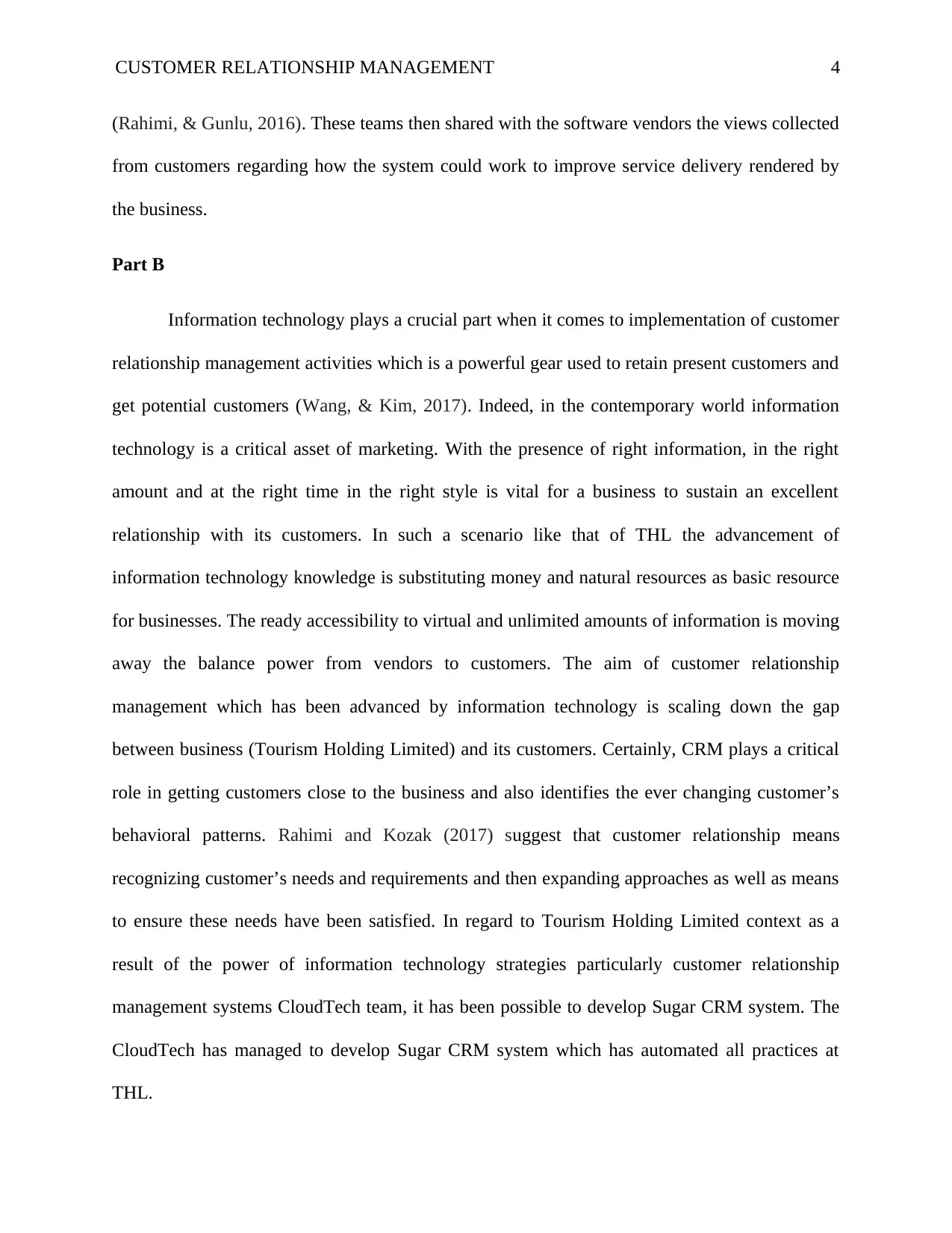
CUSTOMER RELATIONSHIP MANAGEMENT 4
(Rahimi, & Gunlu, 2016). These teams then shared with the software vendors the views collected
from customers regarding how the system could work to improve service delivery rendered by
the business.
Part B
Information technology plays a crucial part when it comes to implementation of customer
relationship management activities which is a powerful gear used to retain present customers and
get potential customers (Wang, & Kim, 2017). Indeed, in the contemporary world information
technology is a critical asset of marketing. With the presence of right information, in the right
amount and at the right time in the right style is vital for a business to sustain an excellent
relationship with its customers. In such a scenario like that of THL the advancement of
information technology knowledge is substituting money and natural resources as basic resource
for businesses. The ready accessibility to virtual and unlimited amounts of information is moving
away the balance power from vendors to customers. The aim of customer relationship
management which has been advanced by information technology is scaling down the gap
between business (Tourism Holding Limited) and its customers. Certainly, CRM plays a critical
role in getting customers close to the business and also identifies the ever changing customer’s
behavioral patterns. Rahimi and Kozak (2017) suggest that customer relationship means
recognizing customer’s needs and requirements and then expanding approaches as well as means
to ensure these needs have been satisfied. In regard to Tourism Holding Limited context as a
result of the power of information technology strategies particularly customer relationship
management systems CloudTech team, it has been possible to develop Sugar CRM system. The
CloudTech has managed to develop Sugar CRM system which has automated all practices at
THL.
(Rahimi, & Gunlu, 2016). These teams then shared with the software vendors the views collected
from customers regarding how the system could work to improve service delivery rendered by
the business.
Part B
Information technology plays a crucial part when it comes to implementation of customer
relationship management activities which is a powerful gear used to retain present customers and
get potential customers (Wang, & Kim, 2017). Indeed, in the contemporary world information
technology is a critical asset of marketing. With the presence of right information, in the right
amount and at the right time in the right style is vital for a business to sustain an excellent
relationship with its customers. In such a scenario like that of THL the advancement of
information technology knowledge is substituting money and natural resources as basic resource
for businesses. The ready accessibility to virtual and unlimited amounts of information is moving
away the balance power from vendors to customers. The aim of customer relationship
management which has been advanced by information technology is scaling down the gap
between business (Tourism Holding Limited) and its customers. Certainly, CRM plays a critical
role in getting customers close to the business and also identifies the ever changing customer’s
behavioral patterns. Rahimi and Kozak (2017) suggest that customer relationship means
recognizing customer’s needs and requirements and then expanding approaches as well as means
to ensure these needs have been satisfied. In regard to Tourism Holding Limited context as a
result of the power of information technology strategies particularly customer relationship
management systems CloudTech team, it has been possible to develop Sugar CRM system. The
CloudTech has managed to develop Sugar CRM system which has automated all practices at
THL.
Paraphrase This Document
Need a fresh take? Get an instant paraphrase of this document with our AI Paraphraser
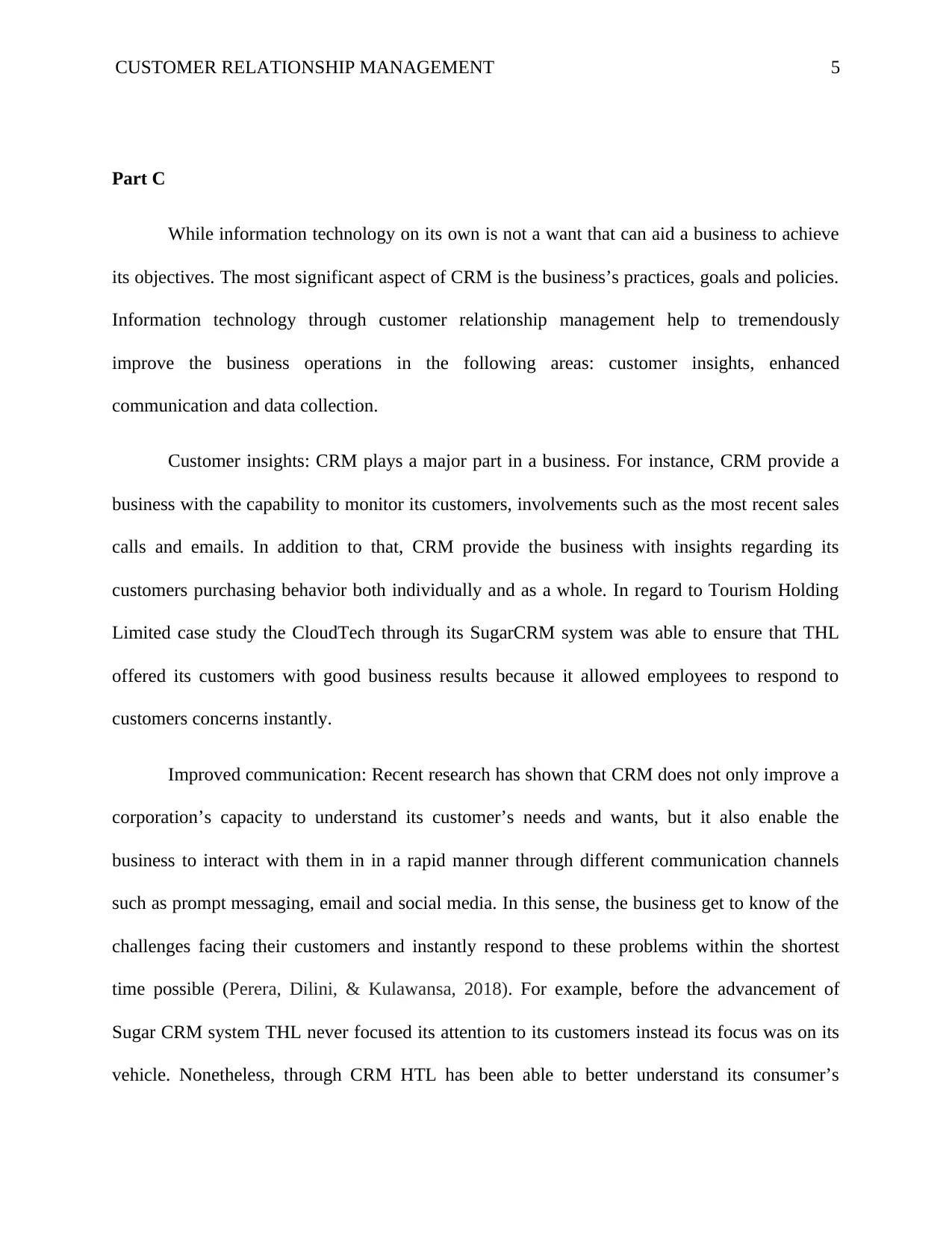
CUSTOMER RELATIONSHIP MANAGEMENT 5
Part C
While information technology on its own is not a want that can aid a business to achieve
its objectives. The most significant aspect of CRM is the business’s practices, goals and policies.
Information technology through customer relationship management help to tremendously
improve the business operations in the following areas: customer insights, enhanced
communication and data collection.
Customer insights: CRM plays a major part in a business. For instance, CRM provide a
business with the capability to monitor its customers, involvements such as the most recent sales
calls and emails. In addition to that, CRM provide the business with insights regarding its
customers purchasing behavior both individually and as a whole. In regard to Tourism Holding
Limited case study the CloudTech through its SugarCRM system was able to ensure that THL
offered its customers with good business results because it allowed employees to respond to
customers concerns instantly.
Improved communication: Recent research has shown that CRM does not only improve a
corporation’s capacity to understand its customer’s needs and wants, but it also enable the
business to interact with them in in a rapid manner through different communication channels
such as prompt messaging, email and social media. In this sense, the business get to know of the
challenges facing their customers and instantly respond to these problems within the shortest
time possible (Perera, Dilini, & Kulawansa, 2018). For example, before the advancement of
Sugar CRM system THL never focused its attention to its customers instead its focus was on its
vehicle. Nonetheless, through CRM HTL has been able to better understand its consumer’s
Part C
While information technology on its own is not a want that can aid a business to achieve
its objectives. The most significant aspect of CRM is the business’s practices, goals and policies.
Information technology through customer relationship management help to tremendously
improve the business operations in the following areas: customer insights, enhanced
communication and data collection.
Customer insights: CRM plays a major part in a business. For instance, CRM provide a
business with the capability to monitor its customers, involvements such as the most recent sales
calls and emails. In addition to that, CRM provide the business with insights regarding its
customers purchasing behavior both individually and as a whole. In regard to Tourism Holding
Limited case study the CloudTech through its SugarCRM system was able to ensure that THL
offered its customers with good business results because it allowed employees to respond to
customers concerns instantly.
Improved communication: Recent research has shown that CRM does not only improve a
corporation’s capacity to understand its customer’s needs and wants, but it also enable the
business to interact with them in in a rapid manner through different communication channels
such as prompt messaging, email and social media. In this sense, the business get to know of the
challenges facing their customers and instantly respond to these problems within the shortest
time possible (Perera, Dilini, & Kulawansa, 2018). For example, before the advancement of
Sugar CRM system THL never focused its attention to its customers instead its focus was on its
vehicle. Nonetheless, through CRM HTL has been able to better understand its consumer’s
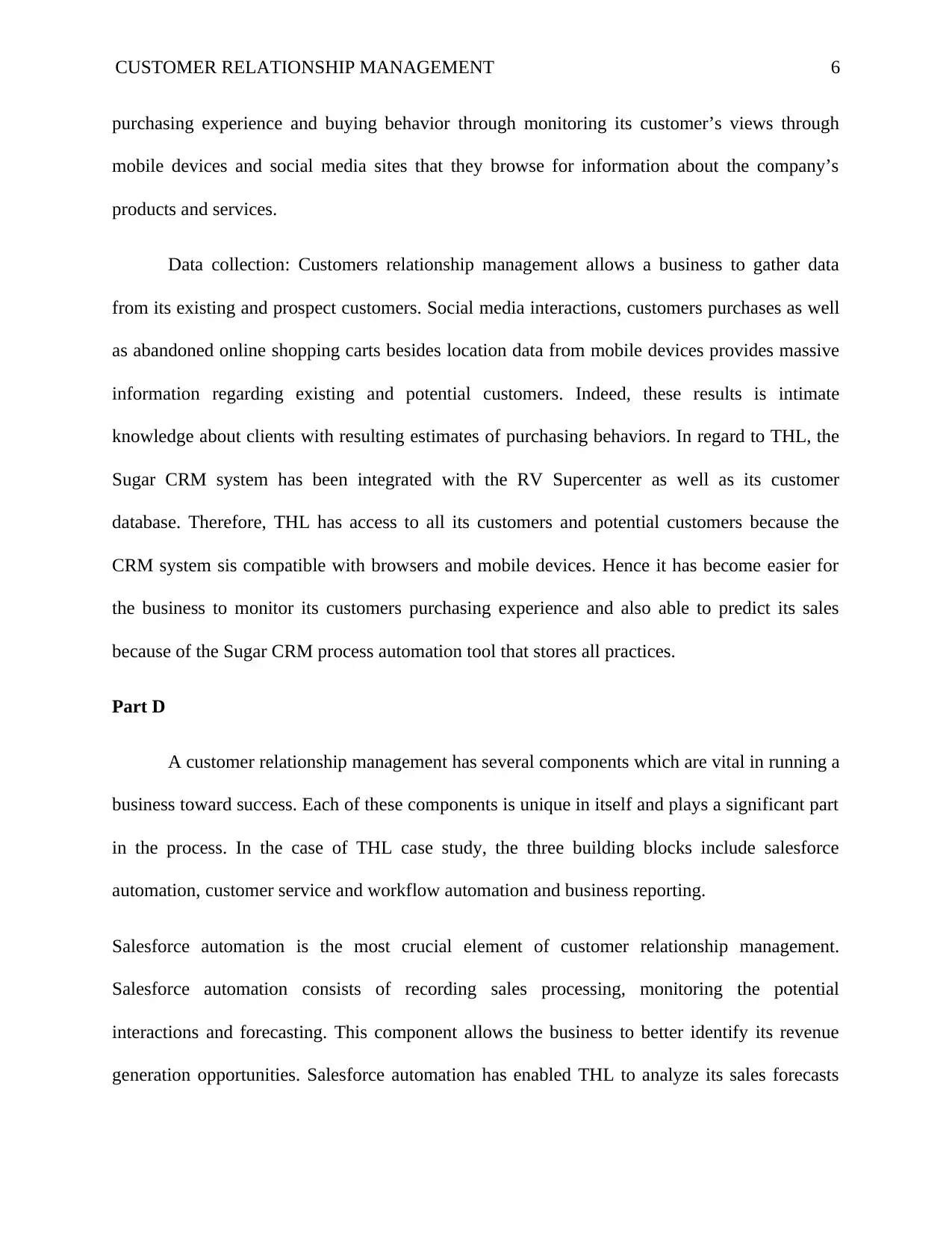
CUSTOMER RELATIONSHIP MANAGEMENT 6
purchasing experience and buying behavior through monitoring its customer’s views through
mobile devices and social media sites that they browse for information about the company’s
products and services.
Data collection: Customers relationship management allows a business to gather data
from its existing and prospect customers. Social media interactions, customers purchases as well
as abandoned online shopping carts besides location data from mobile devices provides massive
information regarding existing and potential customers. Indeed, these results is intimate
knowledge about clients with resulting estimates of purchasing behaviors. In regard to THL, the
Sugar CRM system has been integrated with the RV Supercenter as well as its customer
database. Therefore, THL has access to all its customers and potential customers because the
CRM system sis compatible with browsers and mobile devices. Hence it has become easier for
the business to monitor its customers purchasing experience and also able to predict its sales
because of the Sugar CRM process automation tool that stores all practices.
Part D
A customer relationship management has several components which are vital in running a
business toward success. Each of these components is unique in itself and plays a significant part
in the process. In the case of THL case study, the three building blocks include salesforce
automation, customer service and workflow automation and business reporting.
Salesforce automation is the most crucial element of customer relationship management.
Salesforce automation consists of recording sales processing, monitoring the potential
interactions and forecasting. This component allows the business to better identify its revenue
generation opportunities. Salesforce automation has enabled THL to analyze its sales forecasts
purchasing experience and buying behavior through monitoring its customer’s views through
mobile devices and social media sites that they browse for information about the company’s
products and services.
Data collection: Customers relationship management allows a business to gather data
from its existing and prospect customers. Social media interactions, customers purchases as well
as abandoned online shopping carts besides location data from mobile devices provides massive
information regarding existing and potential customers. Indeed, these results is intimate
knowledge about clients with resulting estimates of purchasing behaviors. In regard to THL, the
Sugar CRM system has been integrated with the RV Supercenter as well as its customer
database. Therefore, THL has access to all its customers and potential customers because the
CRM system sis compatible with browsers and mobile devices. Hence it has become easier for
the business to monitor its customers purchasing experience and also able to predict its sales
because of the Sugar CRM process automation tool that stores all practices.
Part D
A customer relationship management has several components which are vital in running a
business toward success. Each of these components is unique in itself and plays a significant part
in the process. In the case of THL case study, the three building blocks include salesforce
automation, customer service and workflow automation and business reporting.
Salesforce automation is the most crucial element of customer relationship management.
Salesforce automation consists of recording sales processing, monitoring the potential
interactions and forecasting. This component allows the business to better identify its revenue
generation opportunities. Salesforce automation has enabled THL to analyze its sales forecasts
⊘ This is a preview!⊘
Do you want full access?
Subscribe today to unlock all pages.

Trusted by 1+ million students worldwide
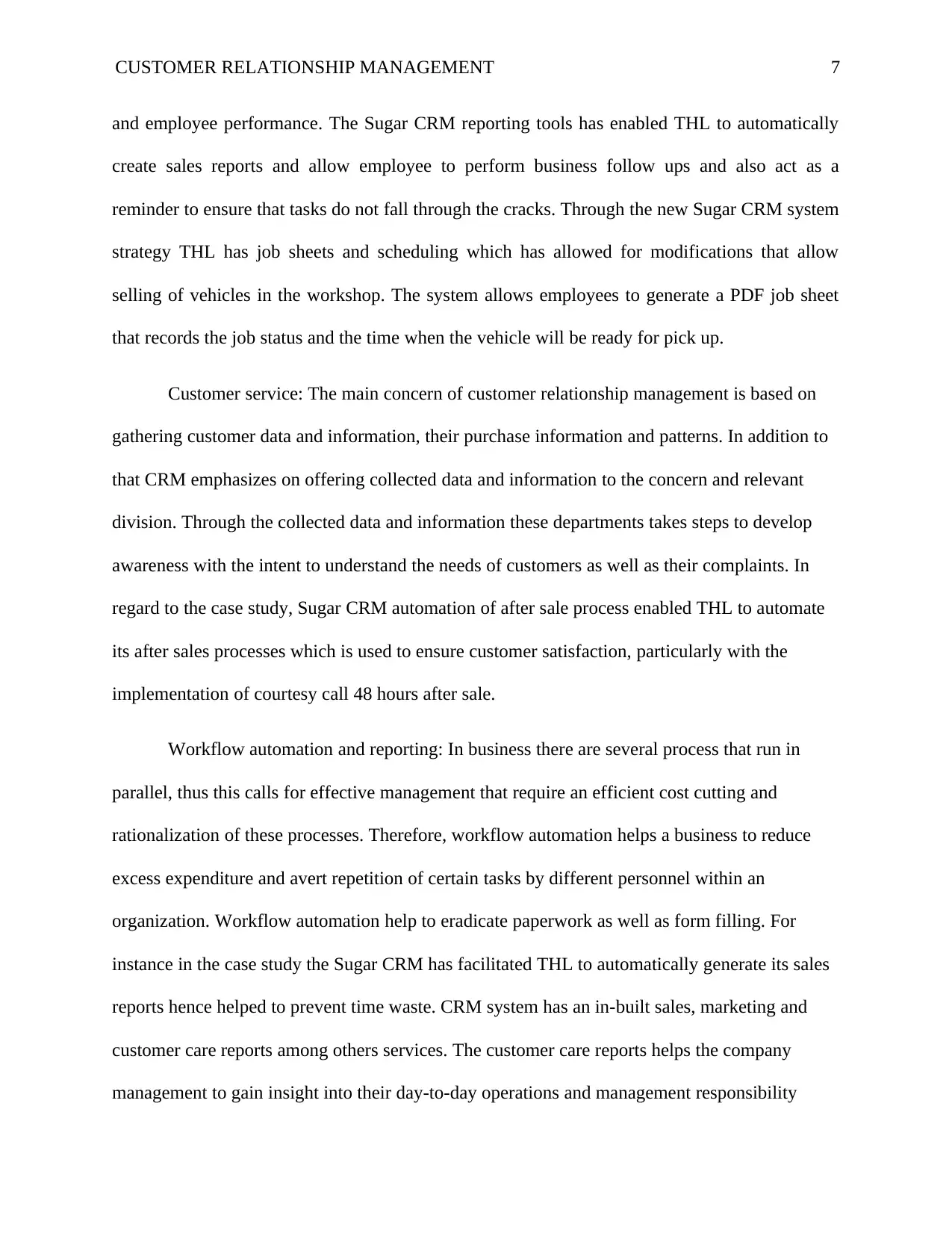
CUSTOMER RELATIONSHIP MANAGEMENT 7
and employee performance. The Sugar CRM reporting tools has enabled THL to automatically
create sales reports and allow employee to perform business follow ups and also act as a
reminder to ensure that tasks do not fall through the cracks. Through the new Sugar CRM system
strategy THL has job sheets and scheduling which has allowed for modifications that allow
selling of vehicles in the workshop. The system allows employees to generate a PDF job sheet
that records the job status and the time when the vehicle will be ready for pick up.
Customer service: The main concern of customer relationship management is based on
gathering customer data and information, their purchase information and patterns. In addition to
that CRM emphasizes on offering collected data and information to the concern and relevant
division. Through the collected data and information these departments takes steps to develop
awareness with the intent to understand the needs of customers as well as their complaints. In
regard to the case study, Sugar CRM automation of after sale process enabled THL to automate
its after sales processes which is used to ensure customer satisfaction, particularly with the
implementation of courtesy call 48 hours after sale.
Workflow automation and reporting: In business there are several process that run in
parallel, thus this calls for effective management that require an efficient cost cutting and
rationalization of these processes. Therefore, workflow automation helps a business to reduce
excess expenditure and avert repetition of certain tasks by different personnel within an
organization. Workflow automation help to eradicate paperwork as well as form filling. For
instance in the case study the Sugar CRM has facilitated THL to automatically generate its sales
reports hence helped to prevent time waste. CRM system has an in-built sales, marketing and
customer care reports among others services. The customer care reports helps the company
management to gain insight into their day-to-day operations and management responsibility
and employee performance. The Sugar CRM reporting tools has enabled THL to automatically
create sales reports and allow employee to perform business follow ups and also act as a
reminder to ensure that tasks do not fall through the cracks. Through the new Sugar CRM system
strategy THL has job sheets and scheduling which has allowed for modifications that allow
selling of vehicles in the workshop. The system allows employees to generate a PDF job sheet
that records the job status and the time when the vehicle will be ready for pick up.
Customer service: The main concern of customer relationship management is based on
gathering customer data and information, their purchase information and patterns. In addition to
that CRM emphasizes on offering collected data and information to the concern and relevant
division. Through the collected data and information these departments takes steps to develop
awareness with the intent to understand the needs of customers as well as their complaints. In
regard to the case study, Sugar CRM automation of after sale process enabled THL to automate
its after sales processes which is used to ensure customer satisfaction, particularly with the
implementation of courtesy call 48 hours after sale.
Workflow automation and reporting: In business there are several process that run in
parallel, thus this calls for effective management that require an efficient cost cutting and
rationalization of these processes. Therefore, workflow automation helps a business to reduce
excess expenditure and avert repetition of certain tasks by different personnel within an
organization. Workflow automation help to eradicate paperwork as well as form filling. For
instance in the case study the Sugar CRM has facilitated THL to automatically generate its sales
reports hence helped to prevent time waste. CRM system has an in-built sales, marketing and
customer care reports among others services. The customer care reports helps the company
management to gain insight into their day-to-day operations and management responsibility
Paraphrase This Document
Need a fresh take? Get an instant paraphrase of this document with our AI Paraphraser
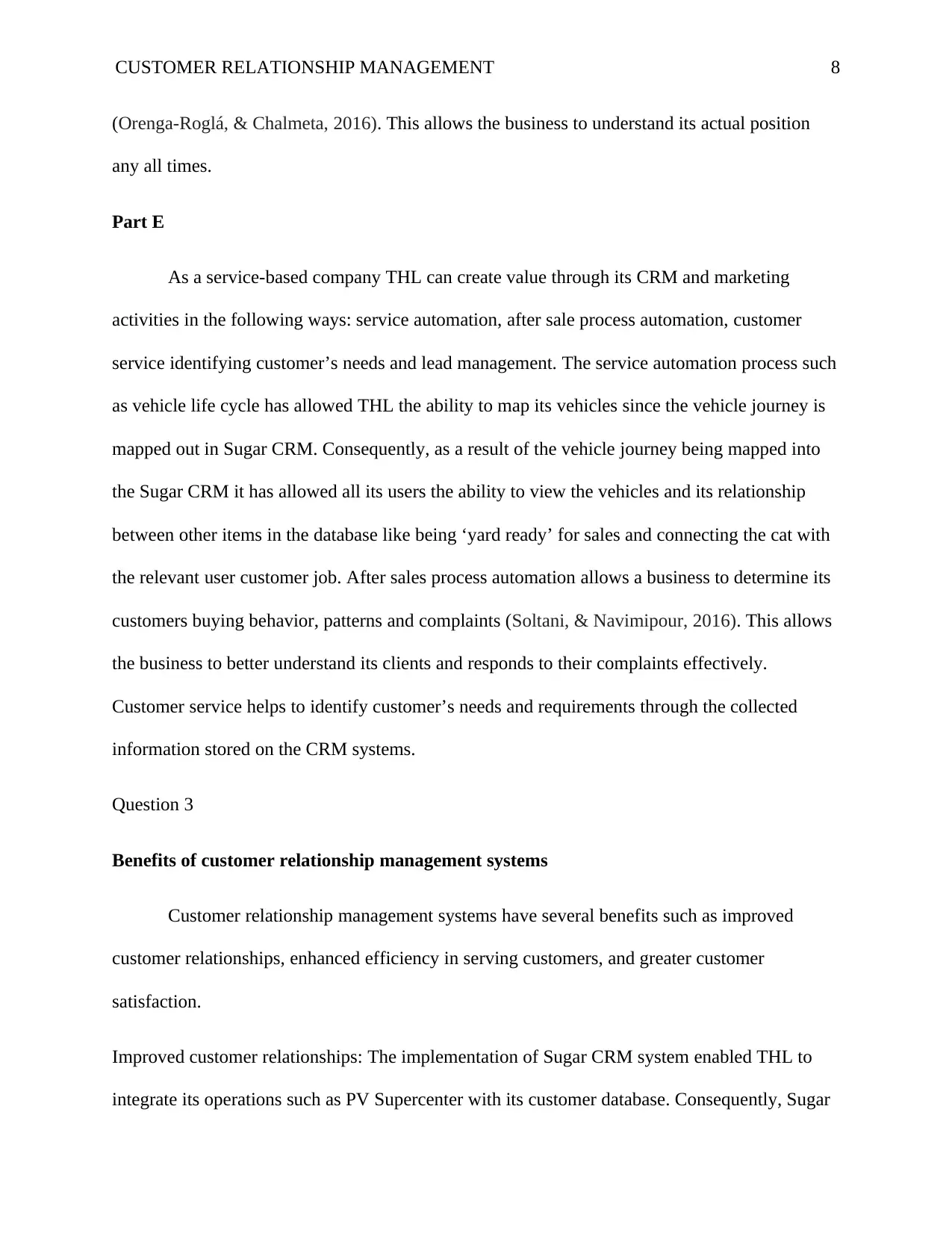
CUSTOMER RELATIONSHIP MANAGEMENT 8
(Orenga-Roglá, & Chalmeta, 2016). This allows the business to understand its actual position
any all times.
Part E
As a service-based company THL can create value through its CRM and marketing
activities in the following ways: service automation, after sale process automation, customer
service identifying customer’s needs and lead management. The service automation process such
as vehicle life cycle has allowed THL the ability to map its vehicles since the vehicle journey is
mapped out in Sugar CRM. Consequently, as a result of the vehicle journey being mapped into
the Sugar CRM it has allowed all its users the ability to view the vehicles and its relationship
between other items in the database like being ‘yard ready’ for sales and connecting the cat with
the relevant user customer job. After sales process automation allows a business to determine its
customers buying behavior, patterns and complaints (Soltani, & Navimipour, 2016). This allows
the business to better understand its clients and responds to their complaints effectively.
Customer service helps to identify customer’s needs and requirements through the collected
information stored on the CRM systems.
Question 3
Benefits of customer relationship management systems
Customer relationship management systems have several benefits such as improved
customer relationships, enhanced efficiency in serving customers, and greater customer
satisfaction.
Improved customer relationships: The implementation of Sugar CRM system enabled THL to
integrate its operations such as PV Supercenter with its customer database. Consequently, Sugar
(Orenga-Roglá, & Chalmeta, 2016). This allows the business to understand its actual position
any all times.
Part E
As a service-based company THL can create value through its CRM and marketing
activities in the following ways: service automation, after sale process automation, customer
service identifying customer’s needs and lead management. The service automation process such
as vehicle life cycle has allowed THL the ability to map its vehicles since the vehicle journey is
mapped out in Sugar CRM. Consequently, as a result of the vehicle journey being mapped into
the Sugar CRM it has allowed all its users the ability to view the vehicles and its relationship
between other items in the database like being ‘yard ready’ for sales and connecting the cat with
the relevant user customer job. After sales process automation allows a business to determine its
customers buying behavior, patterns and complaints (Soltani, & Navimipour, 2016). This allows
the business to better understand its clients and responds to their complaints effectively.
Customer service helps to identify customer’s needs and requirements through the collected
information stored on the CRM systems.
Question 3
Benefits of customer relationship management systems
Customer relationship management systems have several benefits such as improved
customer relationships, enhanced efficiency in serving customers, and greater customer
satisfaction.
Improved customer relationships: The implementation of Sugar CRM system enabled THL to
integrate its operations such as PV Supercenter with its customer database. Consequently, Sugar
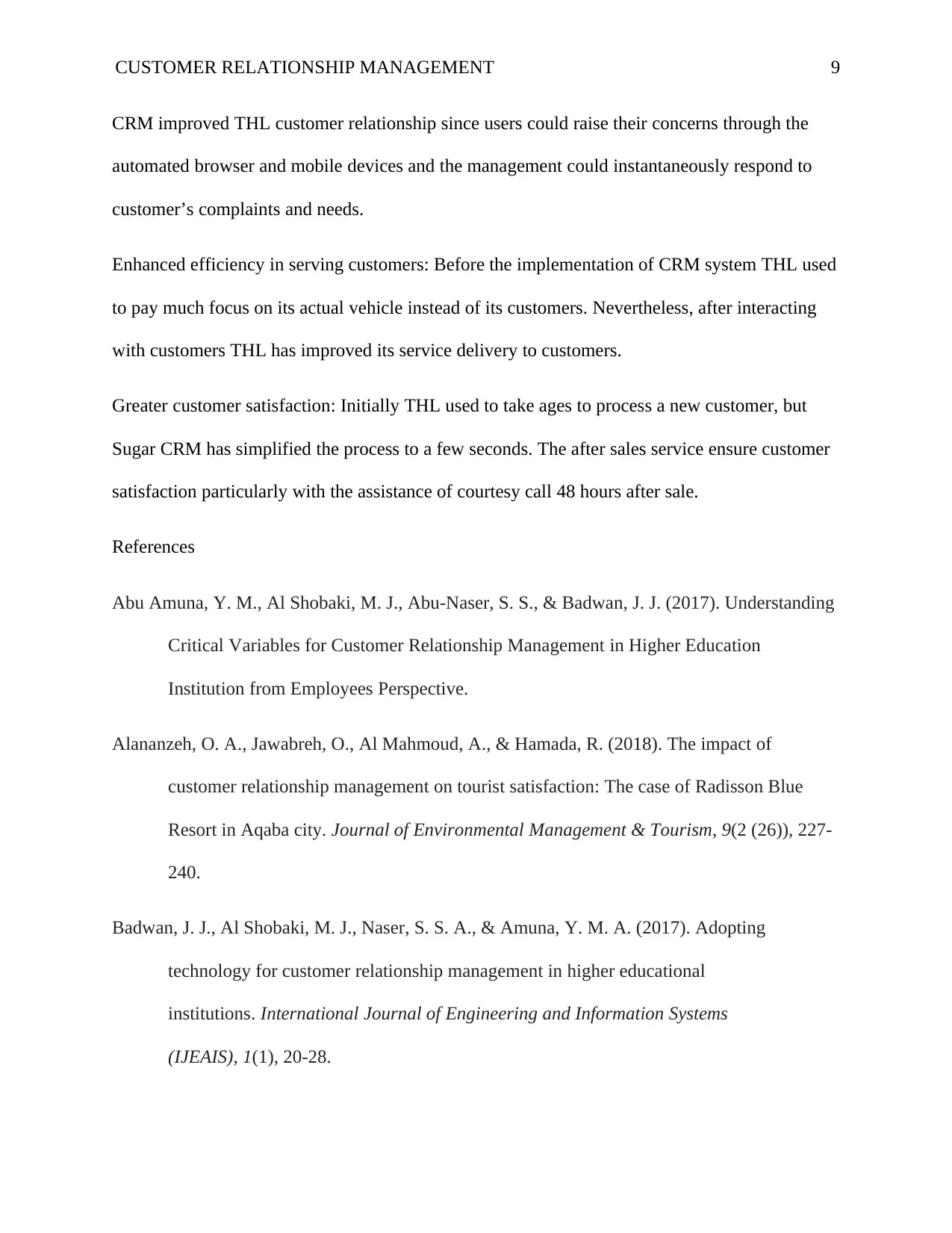
CUSTOMER RELATIONSHIP MANAGEMENT 9
CRM improved THL customer relationship since users could raise their concerns through the
automated browser and mobile devices and the management could instantaneously respond to
customer’s complaints and needs.
Enhanced efficiency in serving customers: Before the implementation of CRM system THL used
to pay much focus on its actual vehicle instead of its customers. Nevertheless, after interacting
with customers THL has improved its service delivery to customers.
Greater customer satisfaction: Initially THL used to take ages to process a new customer, but
Sugar CRM has simplified the process to a few seconds. The after sales service ensure customer
satisfaction particularly with the assistance of courtesy call 48 hours after sale.
References
Abu Amuna, Y. M., Al Shobaki, M. J., Abu-Naser, S. S., & Badwan, J. J. (2017). Understanding
Critical Variables for Customer Relationship Management in Higher Education
Institution from Employees Perspective.
Alananzeh, O. A., Jawabreh, O., Al Mahmoud, A., & Hamada, R. (2018). The impact of
customer relationship management on tourist satisfaction: The case of Radisson Blue
Resort in Aqaba city. Journal of Environmental Management & Tourism, 9(2 (26)), 227-
240.
Badwan, J. J., Al Shobaki, M. J., Naser, S. S. A., & Amuna, Y. M. A. (2017). Adopting
technology for customer relationship management in higher educational
institutions. International Journal of Engineering and Information Systems
(IJEAIS), 1(1), 20-28.
CRM improved THL customer relationship since users could raise their concerns through the
automated browser and mobile devices and the management could instantaneously respond to
customer’s complaints and needs.
Enhanced efficiency in serving customers: Before the implementation of CRM system THL used
to pay much focus on its actual vehicle instead of its customers. Nevertheless, after interacting
with customers THL has improved its service delivery to customers.
Greater customer satisfaction: Initially THL used to take ages to process a new customer, but
Sugar CRM has simplified the process to a few seconds. The after sales service ensure customer
satisfaction particularly with the assistance of courtesy call 48 hours after sale.
References
Abu Amuna, Y. M., Al Shobaki, M. J., Abu-Naser, S. S., & Badwan, J. J. (2017). Understanding
Critical Variables for Customer Relationship Management in Higher Education
Institution from Employees Perspective.
Alananzeh, O. A., Jawabreh, O., Al Mahmoud, A., & Hamada, R. (2018). The impact of
customer relationship management on tourist satisfaction: The case of Radisson Blue
Resort in Aqaba city. Journal of Environmental Management & Tourism, 9(2 (26)), 227-
240.
Badwan, J. J., Al Shobaki, M. J., Naser, S. S. A., & Amuna, Y. M. A. (2017). Adopting
technology for customer relationship management in higher educational
institutions. International Journal of Engineering and Information Systems
(IJEAIS), 1(1), 20-28.
⊘ This is a preview!⊘
Do you want full access?
Subscribe today to unlock all pages.

Trusted by 1+ million students worldwide
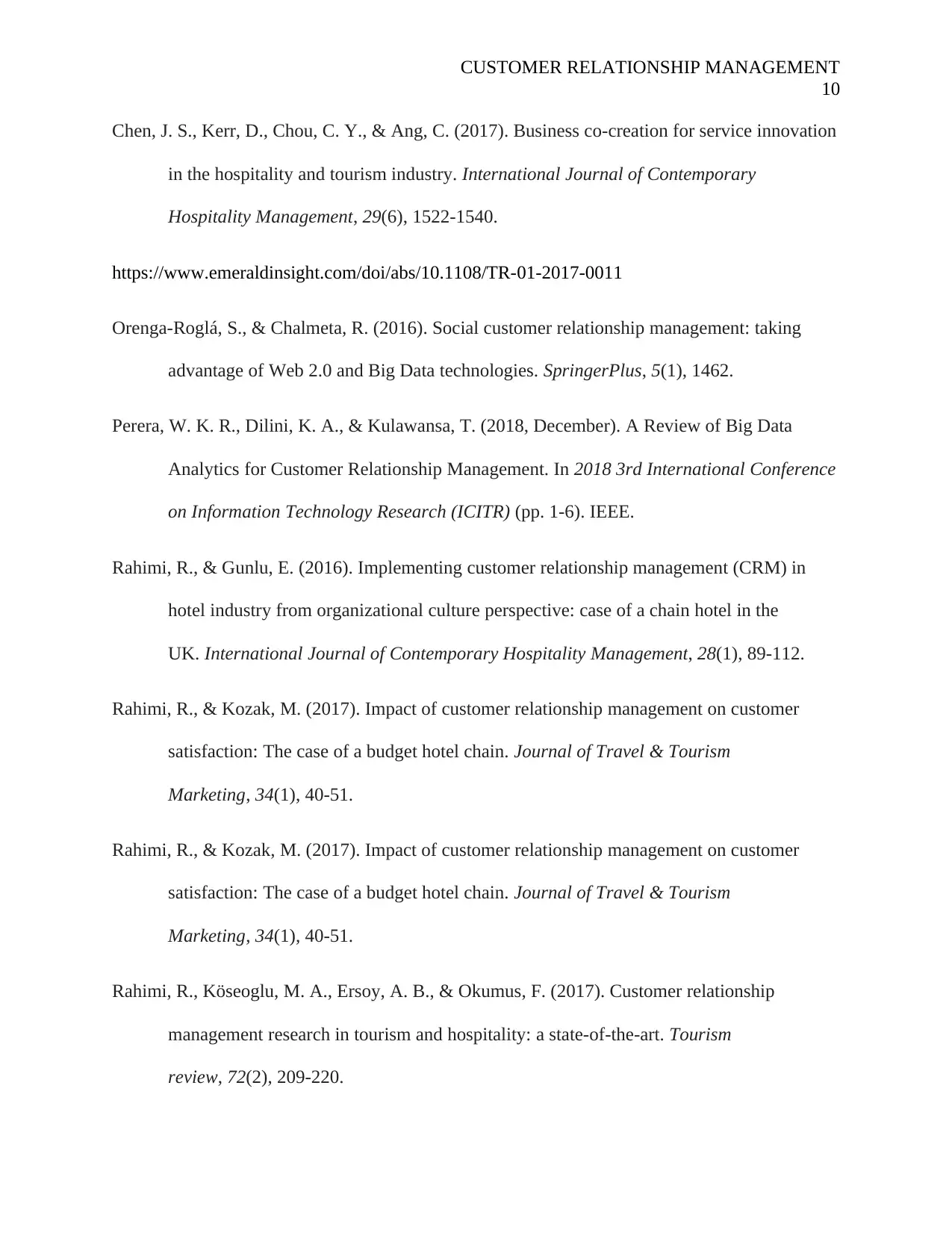
CUSTOMER RELATIONSHIP MANAGEMENT
10
Chen, J. S., Kerr, D., Chou, C. Y., & Ang, C. (2017). Business co-creation for service innovation
in the hospitality and tourism industry. International Journal of Contemporary
Hospitality Management, 29(6), 1522-1540.
https://www.emeraldinsight.com/doi/abs/10.1108/TR-01-2017-0011
Orenga-Roglá, S., & Chalmeta, R. (2016). Social customer relationship management: taking
advantage of Web 2.0 and Big Data technologies. SpringerPlus, 5(1), 1462.
Perera, W. K. R., Dilini, K. A., & Kulawansa, T. (2018, December). A Review of Big Data
Analytics for Customer Relationship Management. In 2018 3rd International Conference
on Information Technology Research (ICITR) (pp. 1-6). IEEE.
Rahimi, R., & Gunlu, E. (2016). Implementing customer relationship management (CRM) in
hotel industry from organizational culture perspective: case of a chain hotel in the
UK. International Journal of Contemporary Hospitality Management, 28(1), 89-112.
Rahimi, R., & Kozak, M. (2017). Impact of customer relationship management on customer
satisfaction: The case of a budget hotel chain. Journal of Travel & Tourism
Marketing, 34(1), 40-51.
Rahimi, R., & Kozak, M. (2017). Impact of customer relationship management on customer
satisfaction: The case of a budget hotel chain. Journal of Travel & Tourism
Marketing, 34(1), 40-51.
Rahimi, R., Köseoglu, M. A., Ersoy, A. B., & Okumus, F. (2017). Customer relationship
management research in tourism and hospitality: a state-of-the-art. Tourism
review, 72(2), 209-220.
10
Chen, J. S., Kerr, D., Chou, C. Y., & Ang, C. (2017). Business co-creation for service innovation
in the hospitality and tourism industry. International Journal of Contemporary
Hospitality Management, 29(6), 1522-1540.
https://www.emeraldinsight.com/doi/abs/10.1108/TR-01-2017-0011
Orenga-Roglá, S., & Chalmeta, R. (2016). Social customer relationship management: taking
advantage of Web 2.0 and Big Data technologies. SpringerPlus, 5(1), 1462.
Perera, W. K. R., Dilini, K. A., & Kulawansa, T. (2018, December). A Review of Big Data
Analytics for Customer Relationship Management. In 2018 3rd International Conference
on Information Technology Research (ICITR) (pp. 1-6). IEEE.
Rahimi, R., & Gunlu, E. (2016). Implementing customer relationship management (CRM) in
hotel industry from organizational culture perspective: case of a chain hotel in the
UK. International Journal of Contemporary Hospitality Management, 28(1), 89-112.
Rahimi, R., & Kozak, M. (2017). Impact of customer relationship management on customer
satisfaction: The case of a budget hotel chain. Journal of Travel & Tourism
Marketing, 34(1), 40-51.
Rahimi, R., & Kozak, M. (2017). Impact of customer relationship management on customer
satisfaction: The case of a budget hotel chain. Journal of Travel & Tourism
Marketing, 34(1), 40-51.
Rahimi, R., Köseoglu, M. A., Ersoy, A. B., & Okumus, F. (2017). Customer relationship
management research in tourism and hospitality: a state-of-the-art. Tourism
review, 72(2), 209-220.
Paraphrase This Document
Need a fresh take? Get an instant paraphrase of this document with our AI Paraphraser
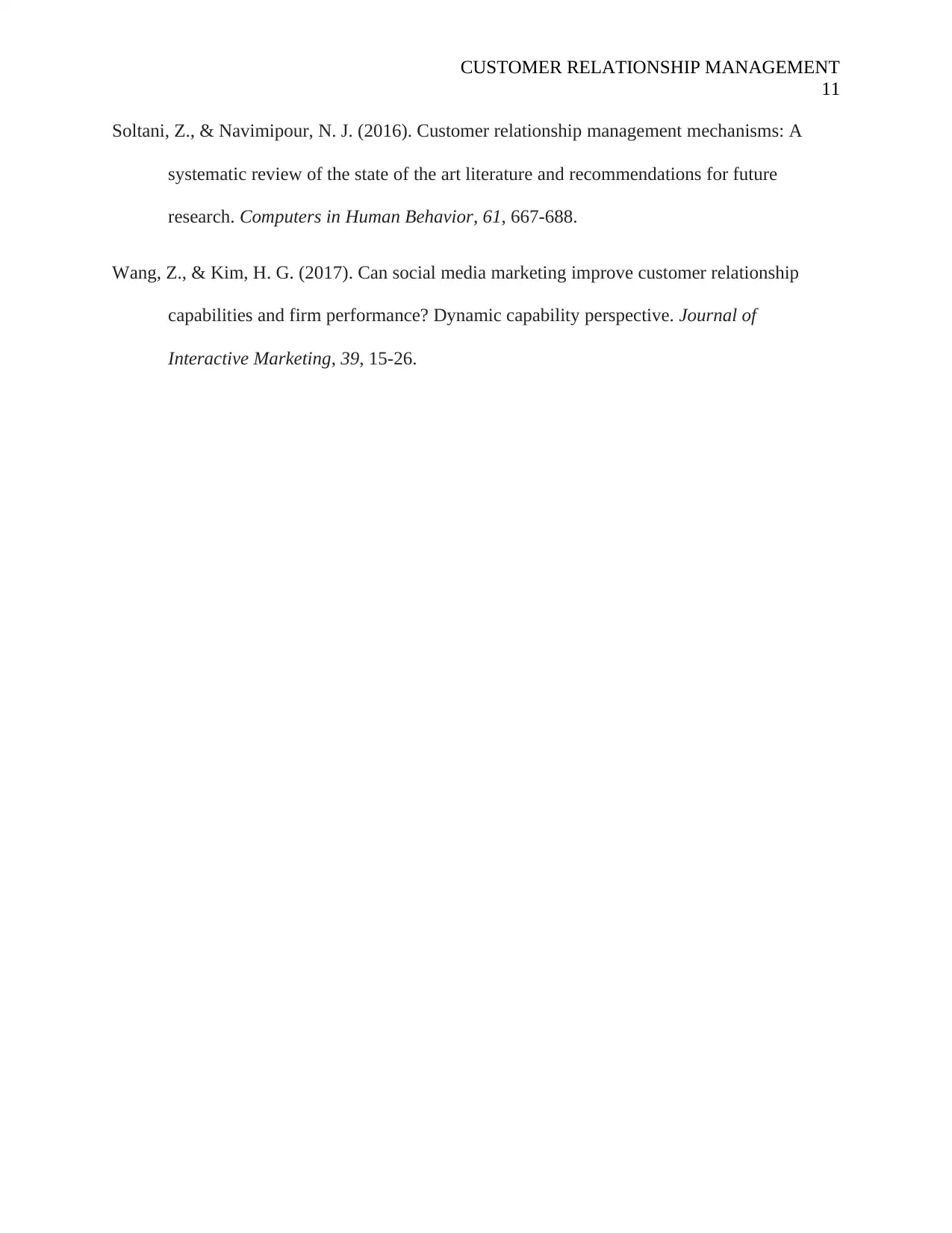
CUSTOMER RELATIONSHIP MANAGEMENT
11
Soltani, Z., & Navimipour, N. J. (2016). Customer relationship management mechanisms: A
systematic review of the state of the art literature and recommendations for future
research. Computers in Human Behavior, 61, 667-688.
Wang, Z., & Kim, H. G. (2017). Can social media marketing improve customer relationship
capabilities and firm performance? Dynamic capability perspective. Journal of
Interactive Marketing, 39, 15-26.
11
Soltani, Z., & Navimipour, N. J. (2016). Customer relationship management mechanisms: A
systematic review of the state of the art literature and recommendations for future
research. Computers in Human Behavior, 61, 667-688.
Wang, Z., & Kim, H. G. (2017). Can social media marketing improve customer relationship
capabilities and firm performance? Dynamic capability perspective. Journal of
Interactive Marketing, 39, 15-26.
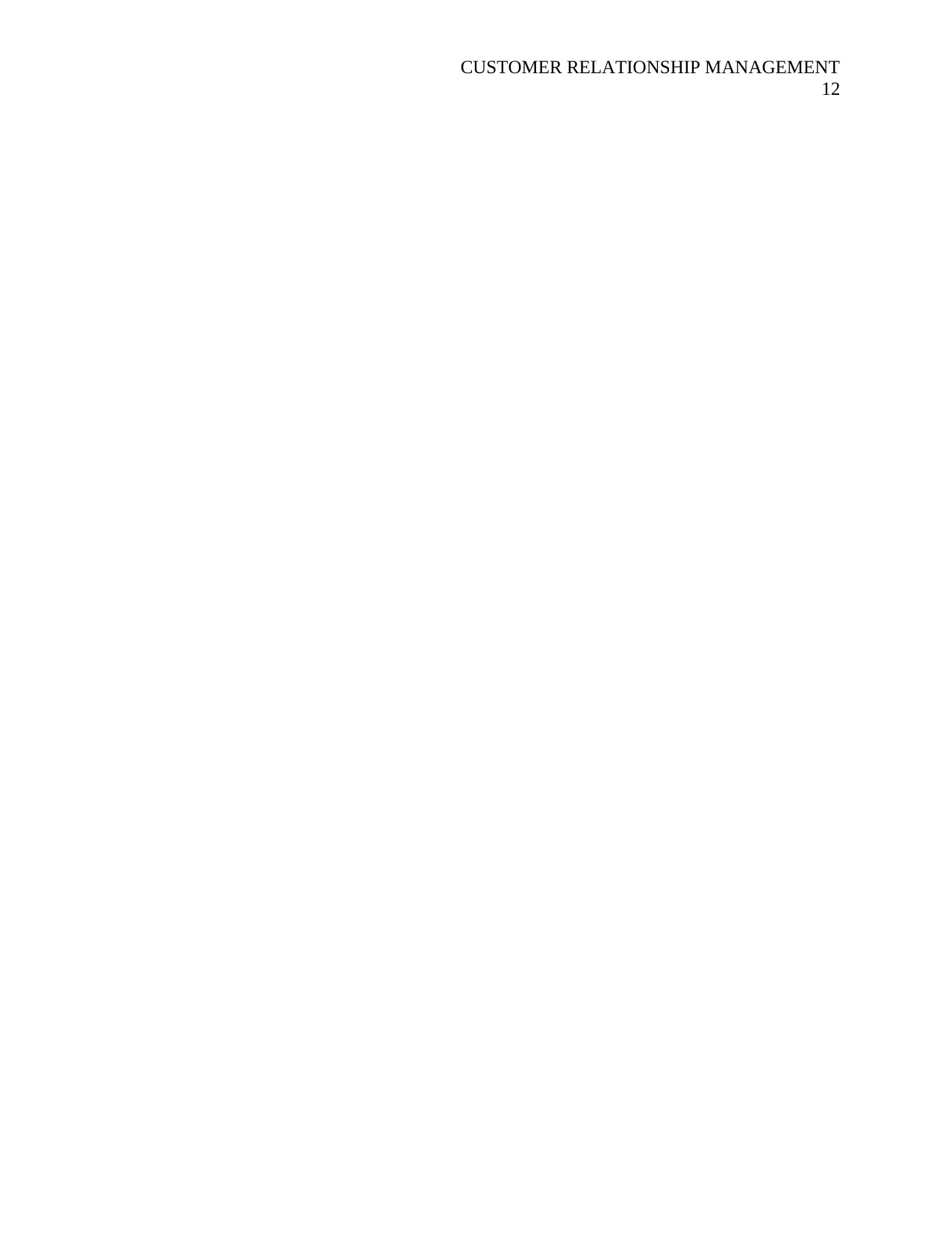
CUSTOMER RELATIONSHIP MANAGEMENT
12
12
⊘ This is a preview!⊘
Do you want full access?
Subscribe today to unlock all pages.

Trusted by 1+ million students worldwide
1 out of 12
Related Documents
Your All-in-One AI-Powered Toolkit for Academic Success.
+13062052269
info@desklib.com
Available 24*7 on WhatsApp / Email
![[object Object]](/_next/static/media/star-bottom.7253800d.svg)
Unlock your academic potential
Copyright © 2020–2025 A2Z Services. All Rights Reserved. Developed and managed by ZUCOL.





